
Date: 2024-10-19 Page is: DBtxt003.php txt00009399
Food
Cooking Cabbage
Cabbage gets a delicious makeover
Burgess COMMENTARY
Peter Burgess
Cabbage gets a delicious makeover By Alexandra Stafford on 8 Mar 2015 6 comments Cross-posted from Food52
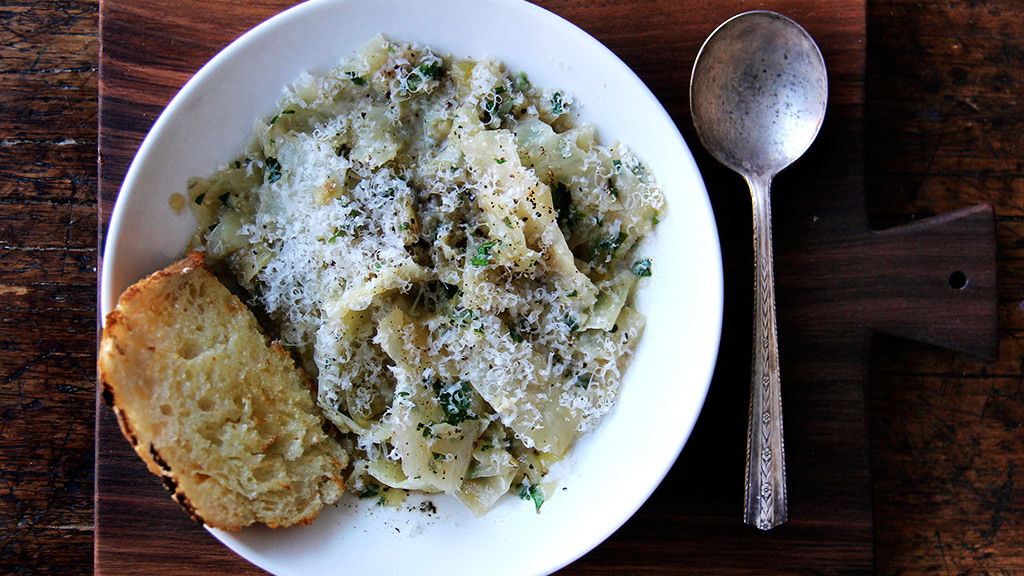
Whenever I find myself eating pounds of vegetables in single sittings, I often have my sheet pan to thank, along with a good bit of salt, high heat, and all of the irresistibly crispy, near-burnt by-products they create.
So, when I found myself making this braised cabbage multiple nights in a row, helping myself to thirds every evening, nearly polishing off whole heads for dinner, I thought: Really? Soft, pallid cabbage ribbons have me hankering for more? A braise unadorned by a single crunchy breadcrumb or cube of crisp pancetta has me this enamored? How?
This recipe comes from Prune, Gabrielle Hamilton’s first cookbook, and, like many of the vegetable recipes included in the book, relies on a minimal but big-flavor ingredient list and good technique. Here, half a head of garlic, eight anchovies, a stick of butter, sliced cabbage, and a small amount of water braise until the cabbage turns “watercolor green” and soft in texture but still able to hold its shape. Hamilton notes that if the cabbage is braised properly, with a tight-fitting lid — she suggests using both parchment and foil to make a seal — condensation will drip from the lid into the pot, which, along with the sweet liquid drawn from the cabbage, will create a rich, flavorful broth.
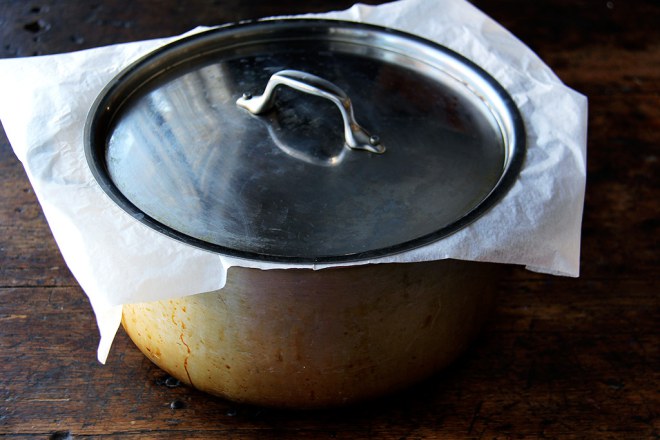 cabbage2Alexandra Stafford
cabbage2Alexandra Stafford
It may take as long as an hour for the cabbage to braise, but the process is mostly hands-off, and the preparation is astonishingly simple — garlic is peeled but not minced, anchovies are left whole, cabbage is washed but not dried. Unlike traditional braises that start with high heat and finish with low heat, this one moves at a leisurely pace from the moment the garlic and anchovies enter the pot until the last hunk of butter dissolves into the sauce.
What I love almost as much as the finished cabbage itself is how the recipe is dictated, each step written in such a way that offers both direction and purpose. For instance, instead of instructing readers to cook the garlic over low heat, Hamilton warns, “Do not fry or otherwise brown the garlic and anchovy,” noting she wants it to “take on a sweet quality rather than a nutty one.” Or, “Stir in a good chunk of cold butter with a wooden spoon and shake the pot a bit as well. This will turn the cabbage a bit creamy and take off any of the hard saltiness of the anchovy.”
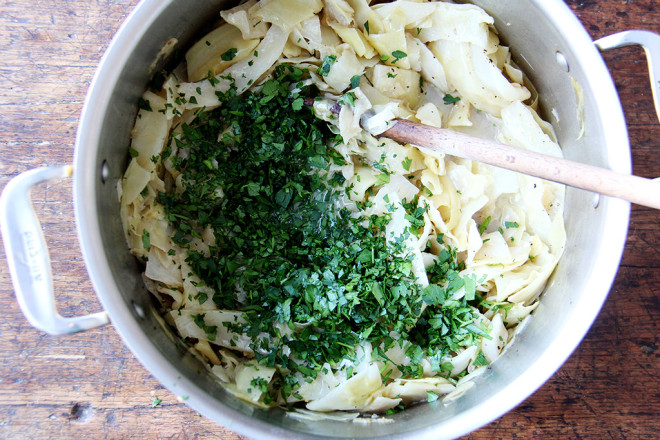 cabbage3Alexandra Stafford
cabbage3Alexandra Stafford
It’s nice having answers to the questions that so often arise while cooking, and Hamilton’s instructions throughout the book leave you with no question as to where she wants the finished dish to go. With so much clarity outlined in each recipe, you might fear straying from her guidance. But if you dare to take this recipe one step further, a squeeze of lemon and a handful of parsley offer an acidity and freshness that nicely complement the sweet, briny broth. A showering of Parmesan and a heel of crusty bread turn this side dish into a meal you’ll want to make again and again, one that will leave you with a single unanswered question: Did I really just eat two pounds of cabbage in one sitting? If only Hamilton were by your side to answer.
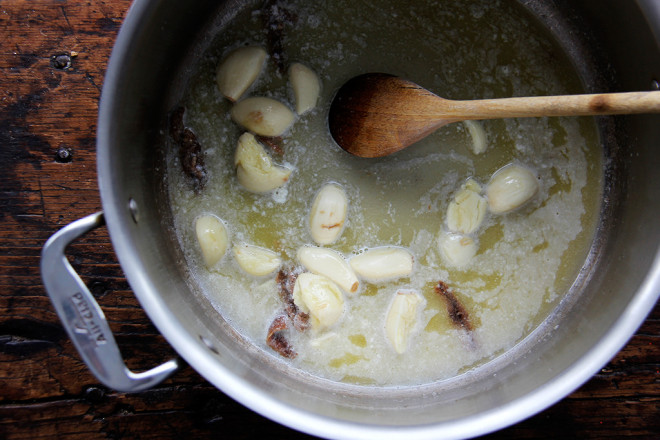 cabbage4Alexandra Stafford
cabbage4Alexandra Stafford
Selecting and storing your cabbage:
Cabbage should feel firm and heavy with shiny, tight leaves laid against each other. Store it in a cool environment such as your fridge, basement, or garage, and when you’re ready to prep, remove any outer wilted or scraggly leaves.
If you’re preparing the cabbage for a raw salad, slice it in half through its core, then cut out the triangular-shaped core in each half with a sharp knife. If the cabbage looks dirty, rinse or soak until dirt is removed.
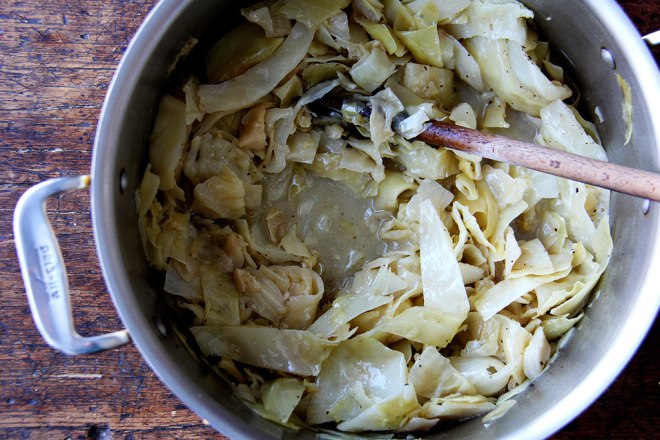 cabbage5Alexandra Stafford
cabbage5Alexandra Stafford
Using your cabbage:
Raw and fermented:
Raw cabbage that’s shredded finely makes a great crunchy salad or slaw. Mix it with other thinly sliced vegetables, fruits, dried fruits, nuts, and herbs, and toss with any number of dressings, from mayonnaise-based to ginger-soy to spicy, honey-lime.
If you’re feeling adventurous, try making classic sauerkraut, but be sure to leave two weeks for the fermentation. Don’t have the patience? Make krautsalat — a cross between sauerkraut and slaw — made with five ingredients, ready in just about an hour.
 cabbage6Alexandra Stafford
cabbage6Alexandra Stafford
Cooked:
Cabbage can be cooked in countless ways: sliced and sautéed or stir-fried; cut into wedges and roasted, braised, blanched and used as a wrap for ground meats and rice; or wrapped around fish before steaming. Here are a few of my favorite ways to use it, if I’m not making this braise:
Make Okonomiyaki, an eggy and crisp, Kyoto-style pancake, studded with shrimp, cabbage, and scallions, accompanied by a soy-and-Sriracha mayo dipping sauce.
Shred cabbage finely, and cook it very slowly in the vapors of its own escaping moisture, a technique known as sofegao, which translates to “smothered.” Then add stock and rice and make Marcella Hazan’s rice and smothered cabbage soup.
Or make a classic minestrone following the Italian tradition of relying solely on vegetables, beans, and a scrap of Parmesan rind to flavor of the broth.
Make Madhur Jaffrey’s stir-fried shredded cabbage with fennel seeds and garam masala as a quick but incredibly flavorful side dish.
Braised green cabbage with anchovies and garlic
See the full recipe (and save it and print it) here. Serves 4 to 6 as a side dish
2 pounds green cabbage, cored, halved, and then cut into 1-inch strips 8 anchovy fillets in oil 1/2 head whole garlic, peeled but leaving cloves whole 4 ounces unsalted butter (plus another chunk to add at the end of cooking) Salt to taste Freshly ground black pepper to taste 1 lemon, halved (optional) 1/2 cup chopped parsley (optional) Freshly grated parmesan (optional)
Author Notes: This recipe comes from Prune, Gabrielle Hamilton’s first cookbook, and, like many of the vegetable recipes included in the book, relies on a minimal bu (…more) - Alexandra Stafford Serves 4 to 6 as a side dish 2 pounds heavy, firm regular green cabbage, cored, halved, and then cut into 1-inch strips 8 anchovy fillets in oil 1/2 head whole garlic, peeled but leaving cloves whole 4 ounces unsalted butter (plus another chunk to add at the end) Salt to taste Freshly ground black pepper to taste 1 lemon, halved (optional) 1/2 cup chopped parsley (optional) Freshly grated parmesan (optional) In a large, heavy-bottomed rondeau, heat the butter over medium-low heat. Add the anchovies and garlic and stir around until the garlic softens slightly and the anchovies dissolve a bit. Do not fry or otherwise brown the garlic and anchovy; we want it to just soften and take on a sweet quality rather than a nutty one. Stir frequently and let the garlic and anchovy cook gently and slowly. Rinse the cabbage ribbons under cold running water in a colander and allow to drain without shaking the colander. Whatever water that remains in the crevices is desired. Turn the colander of cabbage out into the rondeau and stir well with the garlic and anchovy, coating all the ribbons with the fat. (Note: At this step, I sprinkle a big pinch of salt over the cabbage.) If this pot has a tight-fitting lid, cover the rondeau and turn down the heat and let the cabbage gently cook over low heat, retaining its own moisture and letting whatever condensation forms on the lid to drip back into the pot. This wants to be a true braise. If the pot does not have a tight-fitting lid, use both parchment and foil to create a tight seal. This can take an hour to braise but sometimes less depending on the cabbage itself. Some heads are sturdier than others. (Note: I find an hour at my burner's lowest setting works perfectly — I don't lift the lid once to check on it anymore. I do use a sheet of parchment paper under the lid, which helps create a tighter seal.) Keep an eye on it and cook until soft watercolor green color; the cabbage should still hold its shape and there should be a rich 'broth' formed from the anchovy, the sweet liquid of the cabbage, and the now very soft cloves of garlic. Into this stir in a good chunk of cold butter with a wooden spoon and shake the pot a bit as well. This will turn the cabbage a bit creamy and take off any of the hard saltiness of the anchovy. Taste the cabbage, add more salt and pepper if necessary, and squeeze half of the lemon into the pot. Stir. Taste and add more lemon juice if desired. Add parsley if using, stir, then spoon into bowls. Grate parmesan over top and pass more lemon on the side